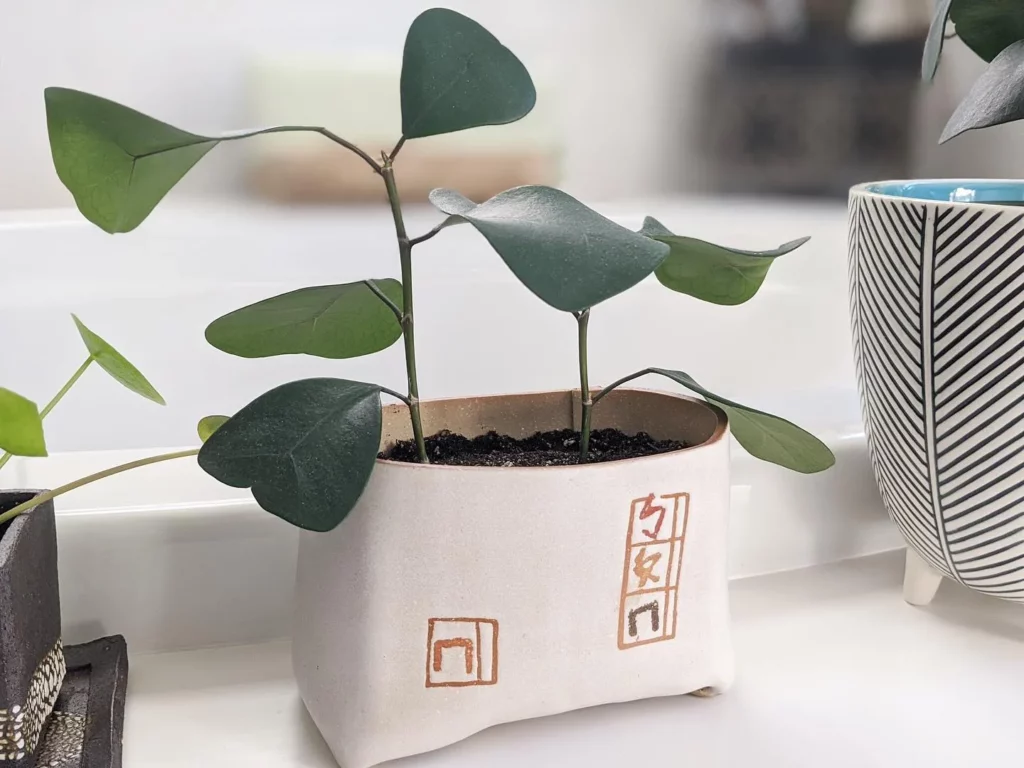The Ficus deltoides, also known as the Triangle Ficus, is a stunning houseplant with unique triangular leaves that add a touch of elegance to any space.
Its foliage is thick and waxy, with a glossy green color that brightens up the room. The triangular shape of the leaves gives this plant its distinctive appearance, making it a conversation starter and a focal point in any indoor setting.
Appearance of Ficus deltoides

This houseplant can grow up to three feet tall, creating a lush and vibrant display. It has a bushy growth habit, with branches that arch gracefully, creating a cascading effect. The branches are adorned with small, unassuming flowers that are often overlooked due to the beauty of its foliage.
With its striking appearance, the Ficus deltoides is an excellent choice for those who want to add a touch of nature to their living spaces. Whether placed on a table, shelf, or hanging basket, this plant is sure to catch the eye and bring a sense of tranquility to any room.
Key Features of Ficus deltoides:
- Triangular-shaped leaves
- Thick and waxy foliage
- Glossy green color
- Bushy growth habit
- Arching branches
- Cascading effect
- Small and inconspicuous flowers
How To Grow Ficus deltoides

If you’re looking to grow a healthy Ficus deltoides, here are the key factors you need to consider:
- Light: Ficus deltoides thrives in bright, indirect light. Place your plant near a window with filtered sunlight or use artificial grow lights if natural light is limited.
- Soil: Use well-draining soil that retains moisture but doesn’t become waterlogged. A mixture of potting soil and perlite or sand works well for Ficus deltoides.
- Watering: Water your Ficus deltoides when the top inch of the soil feels dry. Avoid overwatering, as it can lead to root rot. It’s better to underwater than to overwater this plant.
- Temperature: Ficus deltoides prefers temperatures between 60°F to 75°F (15°C to 24°C). Avoid exposing it to extreme cold or hot drafts.
- Humidity: This plant enjoys slightly humid conditions. You can increase humidity by placing a tray of water near the plant or using a humidifier.
- Fertilizing: Feed your Ficus deltoides with a diluted all-purpose liquid fertilizer during the growing season. Follow the instructions on the fertilizer packaging for the correct dosage.
- Propagation: You can propagate Ficus deltoides through stem cuttings. Take a 4 to 6-inch cutting from a healthy plant and place it in a moist rooting medium. Keep the cutting warm and humid until roots develop.
- Pest Control: Common pests for Ficus deltoides include mealybugs, spider mites, and scales. Treat infestations with insecticidal soap or neem oil, following the instructions on the product label.
No products found.
Propagation Tips for Ficus deltoides

Propagating Ficus deltoides is a rewarding experience that allows you to expand your plant collection or share the joy of growing with others. With a few simple steps, you can create new plants from existing ones and enjoy the satisfaction of watching them thrive.
The most common method of propagating Ficus deltoides is through stem cuttings. Start by selecting a healthy stem with at least two sets of leaves. Using a sharp and clean pair of scissors or gardening shears, cut the stem just below a leaf node.
No products found.
Remove the lower leaves, leaving only the top two sets intact. This will encourage root growth and prevent excessive moisture loss.
Prepare a pot or container with well-draining soil, such as a mix of peat moss and perlite. Moisten the soil slightly to provide a moist environment for the cutting.
Make a small hole in the soil and carefully place the cutting into it, burying it about an inch deep. Gently press the soil around the cutting to ensure good contact.
Place the pot in an area that receives bright, indirect light. Avoid direct sunlight, as it can scorch the cutting. Maintain a consistent level of humidity by covering the pot with a clear plastic bag or using a small greenhouse. This will create a mini greenhouse effect and help retain moisture.
Propagation Tips for Ficus deltoides:
- Choose a healthy stem with at least two sets of leaves.
- Cut the stem just below a leaf node using clean gardening shears.
- Remove the lower leaves, leaving only the top two sets intact.
- Prepare a pot with well-draining soil and slightly moisten it.
- Plant the cutting about an inch deep, ensuring good soil contact.
- Place the pot in bright, indirect light and maintain humidity.
- Monitor the soil moisture and water when it becomes dry.
- After a few weeks, the cutting should develop roots.
- Gradually acclimate the new plant to its permanent location.
Quick Care Overview for Ficus deltoides

To give your Ficus deltoides the best chance to thrive, here’s a quick overview of the care it requires.
Light: Place your Ficus deltoides in a bright location with indirect sunlight. Avoid placing it in direct sunlight as it can scorch the leaves. If you notice the plant leaning towards the light source, rotate it occasionally to ensure even growth.
Watering: Allow the top inch of the soil to dry out before watering your Ficus deltoides. Overwatering can lead to root rot, while underwatering can cause the leaves to drop.
It’s best to water deeply, ensuring that excess water drains out of the pot to prevent waterlogged roots.
No products found.
Temperature and Humidity: Ficus deltoides thrives in temperatures between 60°F to 75°F (15°C to 24°C). Keep the plant away from drafts or extreme temperature changes.
It prefers slightly humid conditions, so misting the leaves or placing a tray of water nearby can help increase humidity levels.
Fertilizing: Feed your Ficus deltoides with a diluted all-purpose liquid fertilizer during the growing season (spring and summer).
Follow the instructions on the fertilizer packaging for proper dilution ratios and frequency. Avoid overfertilizing, as it can lead to nutrient burn.
Light Requirements for Ficus deltoides

Proper light exposure is crucial for the healthy growth of your Ficus deltoides. As a tropical plant, it thrives in bright, indirect light conditions. Placing your Ficus deltoides near a north-facing window or a few feet away from a south-facing window will provide the ideal lighting.
However, direct sunlight should be avoided as it can scorch the leaves. If you notice your Ficus deltoides leaning towards the light source, rotate the plant periodically to ensure even growth.
If you’re growing your Ficus deltoides indoors and don’t have access to sufficient natural light, you can supplement with artificial grow lights. Opt for full-spectrum LED lights to mimic natural sunlight and provide the necessary light intensity for photosynthesis.
Note: If you’re unsure about the light requirements for your specific Ficus deltoides variety, refer to the plant’s care instructions or consult with a local horticulturist.
Signs of Improper Lighting
- Pale or yellowing leaves: This indicates that the plant is receiving insufficient light.
- Leaf drop: Too much direct sunlight or lack of light exposure can cause leaves to drop.
- Lanky growth: If your Ficus deltoides is stretching towards the light source and becoming leggy, it may not be receiving adequate light.
| Light Exposure | Recommended Hours |
|---|---|
| Low Light | 8-10 hours per day |
| Moderate Light | 12-14 hours per day |
| High Light | 14-16 hours per day |
Soil Requirements for Ficus deltoides

Choosing the right soil for your Ficus deltoides is essential to ensure its overall health and vigor. This low-maintenance houseplant thrives in well-draining soil that allows excess water to escape, preventing root rot. A mixture of peat moss, perlite, and sand creates the ideal soil composition for Ficus deltoides, ensuring proper aeration and moisture retention.
| Component | Proportion |
|---|---|
| Peat Moss | 50% |
| Perlite | 25% |
| Sand | 25% |
It’s important to note that Ficus deltoides prefers slightly acidic soil with a pH level between 6.0 and 7.0. Regularly check the soil’s pH level using a testing kit and use additives like dolomite lime or sulfur to adjust it if necessary.
Benefits of Well-Draining Soil
Well-draining soil is crucial for Ficus deltoides because it prevents waterlogged conditions that can lead to root rot and other fungal diseases. Adequate drainage allows the plant’s roots to breathe, absorb essential nutrients, and grow healthy.
It also helps regulate moisture levels, preventing overwatering and the subsequent leaf drop.
- Ensures proper aeration for roots
- Prevents waterlogging and root rot
- Helps regulate moisture levels
- Reduces the risk of fungal diseases
Potting and Repotting Ficus deltoides
Proper potting and repotting techniques play a vital role in the long-term health and well-being of your Ficus deltoides. Choosing the right pot and ensuring proper drainage are essential for preventing root rot and promoting healthy growth.
When potting your Ficus deltoides, select a container that is slightly larger than the current one, allowing room for the roots to expand.
Before repotting, carefully remove the plant from its old container, taking care not to damage the roots. Gently tease out any tangled or circling roots to encourage new growth.
When placing the plant in the new pot, add a layer of well-draining potting soil at the bottom to promote proper drainage.
Tip: It’s a good idea to line the bottom of the pot with a layer of small rocks or broken pottery to further enhance drainage.
Fill the remaining space around the roots with fresh potting soil, ensuring that the plant is positioned at the same depth as before. Lightly press down the soil to remove any air pockets and provide stability. Water the plant thoroughly after repotting to help settle the soil and hydrate the roots.
When to Repot Ficus deltoides
Repotting is typically recommended every 2-3 years or when the plant has outgrown its current container. Signs that your Ficus deltoides may need repotting include roots poking out of the drainage holes, slowed growth, or the pot tipping over easily.
- Choose a pot slightly larger than the current one.
- Ensure proper drainage with a layer of rocks or broken pottery.
- Gently remove the plant from its old container, untangling any circling roots.
- Add fresh potting soil, ensuring the plant is at the same depth as before.
- Water thoroughly to settle the soil and hydrate the roots.
- Repot every 2-3 years or when the plant outgrows its container.
Pruning and Shaping Ficus deltoides
Pruning and shaping your Ficus deltoides can help maintain its size, shape, and overall appearance. Regular pruning not only keeps the plant looking tidy but also encourages new growth and prevents it from becoming too leggy.
When pruning, make clean cuts just above a leaf node or branching point.
One effective method of shaping your Ficus deltoides is by using wire or twine to gently guide its branches into desired positions. This can create an aesthetically pleasing bonsai-like appearance.
Be sure to use soft, flexible wire and adjust it regularly to avoid damaging the plant.
To further enhance the beauty of your Ficus deltoides, you can also remove any dead or yellowing leaves. This not only improves its appearance but also promotes better air circulation and reduces the risk of pests and diseases.
Remember to use clean, sterilized pruning tools to prevent the spread of infections.
Pro Tip: If you want to achieve a fuller and bushier look for your Ficus deltoides, consider pinching back the new growth. This involves using your fingertips or pruning shears to remove the tips of the branches. The plant will respond by producing multiple new shoots, resulting in a denser foliage.
Temperature Requirements for Ficus deltoides
Maintaining the right temperature is crucial in keeping your Ficus deltoides happy and healthy. This low-maintenance houseplant thrives in temperatures between 60°F to 75°F, making it perfect for indoor cultivation.
However, it’s important to note that Ficus deltoides is sensitive to extreme temperature fluctuations, so avoid placing it near drafts or in direct sunlight.
To provide the ideal temperature conditions, place your Ficus deltoides in a room with consistent temperature levels. Avoid exposing it to sudden temperature drops, such as near air conditioning units or open windows during colder months.
If you live in a region with colder winters, consider moving your Ficus deltoides away from drafty areas or provide additional insulation.
On the other hand, if you live in a warmer climate where the temperature exceeds 75°F, it’s crucial to keep your Ficus deltoides away from direct sunlight or intense heat sources.
Excessive heat can cause stress and leaf wilt. Consider placing your plant in a shaded area or using blinds or curtains to filter the sunlight.
Temperature Tips for Ficus deltoides Care
- Keep your Ficus deltoides in a room with a consistent temperature range of 60°F to 75°F.
- Avoid exposing your plant to drafts or extreme temperature fluctuations.
- In colder months, protect your Ficus deltoides from cold drafts or use additional insulation.
- In warmer climates, provide shade and protection from direct sunlight to prevent leaf wilt.
Humidity Requirements for Ficus deltoides
Ficus deltoides thrives in slightly humid conditions, similar to its natural habitat. Maintaining the right humidity level is crucial for the plant’s overall health and growth. Inadequate humidity can lead to dryness of the leaves, while excessive humidity may encourage the growth of fungal diseases.
No products found.
So how can you ensure the optimal humidity for your Ficus deltoides? Here are a few tips:
- Misting: Regularly misting the foliage can help increase humidity levels around the plant. Use a spray bottle filled with clean water to lightly mist the leaves, being careful not to saturate them.
- Grouping: Placing your Ficus deltoides near other houseplants can create a microclimate with higher humidity levels. The plants release moisture through transpiration, raising the humidity in the immediate vicinity.
- Humidifier: If you live in a dry climate or struggle to maintain adequate humidity indoors, using a humidifier can be beneficial. Set it up near your Ficus deltoides to provide a consistent level of humidity.
Watering Ficus deltoides
Watering your Ficus deltoides correctly is crucial for its overall health and vitality. As a low-maintenance houseplant, Ficus deltoides doesn’t require frequent watering, but it’s important to provide it with adequate moisture.
When it comes to watering, the key is to find the right balance. Overwatering can lead to root rot and other issues, while underwatering can cause leaf drop and stunted growth. To determine when to water, check the top inch of soil – if it feels dry to the touch, it’s time to water.
When watering, make sure to thoroughly saturate the soil, allowing water to penetrate the root system. However, avoid leaving the plant sitting in water as it can lead to root rot. Instead, allow any excess water to drain out of the pot, ensuring proper drainage.
In addition to regular watering, it’s important to consider the climate and season when determining the watering frequency for your Ficus deltoides. During the hotter summer months, you may need to increase the frequency of watering, while reducing it during the cooler winter months.
Fertilizing Ficus deltoides
Fertilizing your Ficus deltoides is essential to provide it with the necessary nutrients for healthy growth. The right fertilizer can help your plant thrive and maintain its vibrant appearance. When it comes to fertilizing Ficus deltoides, there are a few key points to keep in mind to ensure optimal results.
No products found.
Firstly, it’s important to choose the right type of fertilizer. A balanced, all-purpose liquid fertilizer works well for Ficus deltoides. Look for a fertilizer with a nitrogen-phosphorus-potassium (NPK) ratio of around 10-10-10 or 20-20-20.
This balanced ratio will provide the plant with essential nutrients for leaf development, root growth, and overall health.
Secondly, timing is crucial. Fertilize your Ficus deltoides during the growing season, which typically spans from spring to early fall. During this time, the plant is actively growing and will benefit the most from additional nutrients.
No products found.
Follow the instructions on the fertilizer packaging for the appropriate dilution ratio and frequency of application.
Lastly, remember that less is more when it comes to fertilizing. Overfertilizing can lead to salt buildup in the soil, which can harm the plant’s roots and cause leaf burn. Be sure to water your Ficus deltoides thoroughly before applying fertilizer and avoid fertilizing when the soil is dry.
This will help prevent damage and ensure the fertilizer is effectively absorbed by the plant.
Pest Control for Ficus deltoides
Protecting your Ficus deltoides from pests is essential to maintain its overall health and prevent damage. Common pests that can affect your Triangle Ficus include mealybugs, spider mites, and scales.
Identifying and treating these pests early on is crucial for the well-being of your plant.
One effective way to control pests is by using natural remedies. For example, you can create a homemade insecticidal soap by mixing mild liquid dish soap with water.
Apply this solution to the affected areas of your Ficus deltoides, such as the undersides of the leaves where pests often hide. You can also use neem oil, which acts as both a pesticide and a fungicide. Dilute the neem oil according to the instructions on the product and spray it onto your plant.
In severe infestations, you may need to turn to chemical insecticides. Look for products specifically labeled for use on Ficus deltoides and follow the instructions carefully.
Remember to apply the insecticide in a well-ventilated area and avoid spraying it directly on the leaves if possible.
Common Problems with Ficus deltoides
While Ficus deltoides is generally a resilient plant, it can face certain problems that you should be aware of. Understanding these issues and taking proactive measures can help keep your Ficus deltoides healthy and thriving.
One common problem is dehydration, which can occur if the plant is not receiving enough water. This can be identified by drooping leaves and dry soil. To remedy this, thoroughly water the plant and ensure that the soil is consistently moist, but not waterlogged.
Additionally, misting the leaves periodically can help create a slightly more humid environment.
Another issue that may arise is leaf drop. This can be caused by various factors, including inconsistent watering, exposure to cold drafts, or sudden changes in light conditions.
To prevent leaf drop, ensure that the plant is not placed near cold windows or vents, and maintain consistent watering and light conditions.
Conclusion
By following the care tips outlined in this guide, you can ensure that your Ficus deltoides thrives and brings beauty to your indoor or outdoor space.
Ficus deltoides, also known as mistletoe fig or Ficus deltoidea, is a low-maintenance houseplant that is perfect for beginners. With its triangular-shaped leaves, it adds an interesting aesthetic to any environment. Whether you choose to grow it indoors or outdoors in warmer regions, the Ficus deltoides is sure to impress.
To keep your Ficus deltoides healthy, it’s important to provide the right conditions. It prefers well-draining soil and bright, indirect light. Watering should be done when the soil is dry, being careful not to overwater as it can lead to leaf drop. A temperature range of 60°F to 75°F and slightly humid conditions are ideal for optimal growth.
Proper fertilization is crucial for the Ficus deltoides. During the growing season, use a diluted all-purpose liquid fertilizer to provide the necessary nutrients. Additionally, propagation can be done through cuttings, allowing you to expand your collection or share with friends and family.
While caring for your Ficus deltoides, it’s important to be mindful of common pests such as mealybugs, spider mites, and scales. If you notice any signs of infestation, treat them promptly with suitable insecticides to prevent further damage.
By incorporating these care essentials and tips into your routine, your Ficus deltoides will thrive and become a stunning addition to your space. Enjoy the beauty and tranquility that this remarkable plant brings to your environment.
Make sure to check out our article on Ficus religiosa Sacred Fig Care Guide. And after reading that Ficus article, check out our article on Ficus triangularis Variegata Care Guide.
FAQ
Q: Is Ficus deltoides suitable for beginners?
A: Yes, Ficus deltoides is a low-maintenance houseplant that is perfect for beginners.
Q: Can Ficus deltoides be grown indoors?
A: Yes, Ficus deltoides can be grown indoors or outdoors in warmer regions.
Q: What kind of light does Ficus deltoides prefer?
A: Ficus deltoides prefers bright, indirect light.
Q: How often should I water Ficus deltoides?
A: Watering should be done when the soil is dry, and it’s important not to overwater as it can cause leaf drop.
Q: What temperature range does Ficus deltoides thrive in?
A: Ficus deltoides thrives in temperatures between 60°F to 75°F.
Q: How should I fertilize Ficus deltoides?
A: Fertilize during the growing season with a diluted all-purpose liquid fertilizer.
Q: How can I propagate Ficus deltoides?
A: Ficus deltoides can be propagated through cuttings.
Q: What are the common pests that affect Ficus deltoides?
A: Common pests include mealybugs, spider mites, and scales, which can be treated with insecticides.
Q: What is the key to proper Ficus deltoides care?
A: Proper care involves maintaining the right temperature, humidity, and light conditions, as well as avoiding overwatering and overfertilizing.
Q: Can Ficus deltoides grow into a tree?
A: Yes, with the right care, Ficus deltoides can grow into a small tree, making it a beautiful addition to any indoor or outdoor space.








